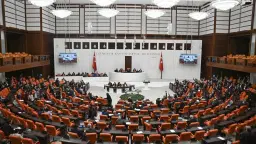ANKARA- TEPAV declared that Turkey's health expenditures and main health indicators converge to EU-15 average. In the period between 1980 and 2008 health expenditures in Turkey increased, life expectancy rose and infant mortality rate reduced significantly.
Evaluation note "How Does the Increase in Health Expenditures Affect Leading Health Indicators?" by TEPAV Research Associate Selin Arslanhan is published.
The note analyzed how the health expenditures and main health indicators over the last three decades changed in comparison with EU-15 countries and other selected countries. Underlining that in 1980 Turkey's per capita health expenditures and per capita GDP corresponded to 9% and 15% of the EU-15 average, respectively, the note said:
"After 1985, pace of increase in per capita health expenditures for each year exceeded the EU-15 average. Pace of increase in health expenditures was the highest in 1995-2000 period whereas a slowdown was observed in 2000-2003 period. Expenditures tended upwards again after 2003. As of 2007, per capita health expenditures in Turkey correspond to 26% of the EU-15 average while per capita GDP reached 23% of the EU-15 average.
Although there are a number of factors that have a role in the increase in health expenditures, three main components, namely out-patient treatment, inpatient treatment and expenditure on medicine and medical equipments are generally examined. Expenditures on medicine make a growing contribution to the increase in total health expenditures over the recent years while the main component is still treatment services. Recently in many countries, inpatient treatment expenditures tend to be replaced by outpatient treatment expenditures. Nonetheless, such a trend cannot be observed in case of Turkey and the number of patients applying to hospitals continues to rise rapidly. Therefore, in 1995-2006 period, inpatient treatment expenditures made the biggest contribution to the rise in per capita health expenditures."
Life expectancy increases, infant mortality decreases
The note maintained that life expectancy and infant mortality, although determined by many factors, are the main indicators used to assess the performance of health systems and underlined that in 1980's life expectancy in Turkey was 58.1 years despite the EU-15 average of 74.2 years. The note continued:
"In the 1980-2008 period, life expectancy in Turkey rose more rapidly than the EU-15 average reaching 72.1 years. Pace of growth of life expectancy slows down after a certain level. In this context this trend is recently observed in Turkey similar to the change in the EU-15 average. Even though Turkey/EU-15 average ratio tends to vary between years, the convergence can be observed for life expectancy as well as for per capita health expenditures.
Another leading health indicator is infant mortality rate. In 1980, infant mortality rate in Turkey was eight times that of the EU-15 average. Though following 1980 infant mortality rate in EU-15 continued to fall down, Turkey achieved much steeper reductions in infant mortality rate. For the period between 1980 and 2007 health expenditures and infant mortality rate in Turkey demonstrate a similar convergence to the EU-15 average. Patterns differed only in the 1995-2000 period where health expenditures increased more rapidly while the pace of fall in infant mortality rate slowed down."
Efficient use and sustainability are of importance ...
The note emphasized that for the sustainability of the improvements in main health indicators the importance attached to and the funds allocated for preventive health services shall be improved and maintained that this way the economic burden of inpatient treatment services can be reduced while the improvements in the leading health indicators will be furthered. TEPAV's evaluation note continued:
"Efficient use and sustainability of health expenditures are of vital importance. This note makes a comparison and assessment on the basis of two leading health indicators. In order to examine the efficiency of the reforms in the health sector and the sustainability of health expenditures, detailed analysis on each reform component must be conducted."




